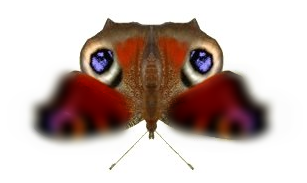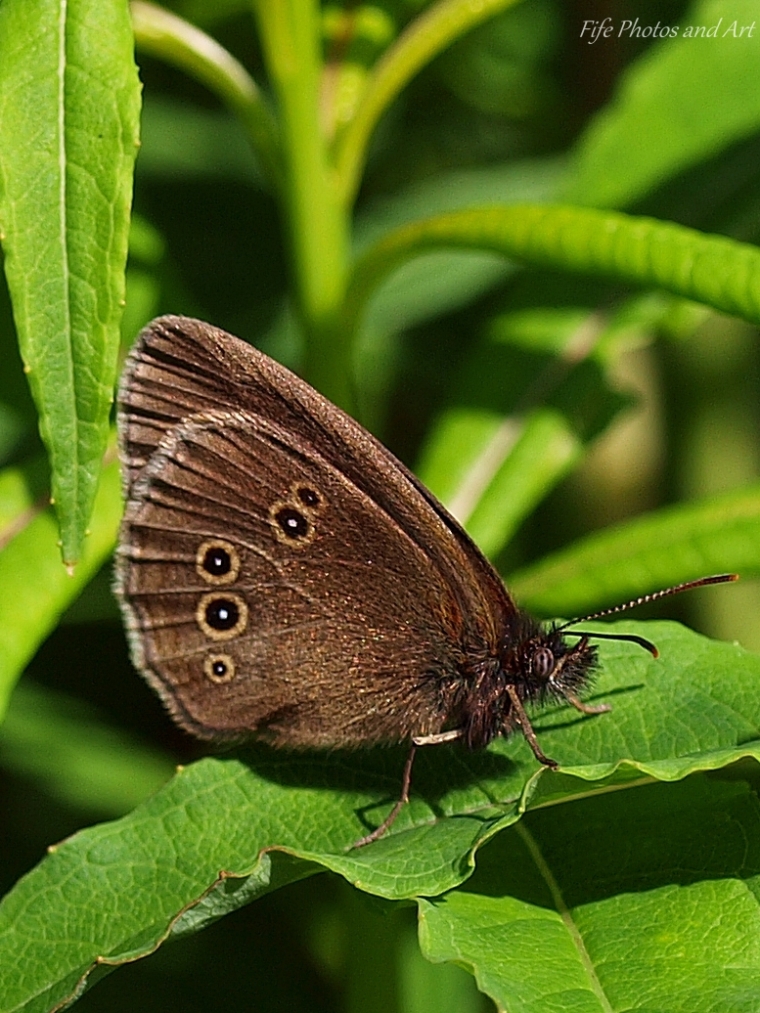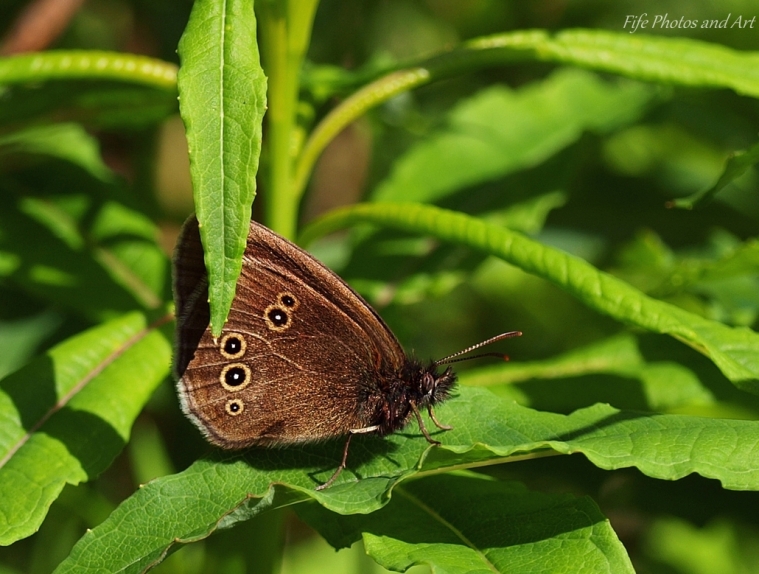The Peacock Butterfly
The Peacock Butterfly (so called because of it’s markings, like those on a peacock’s feathers), uses it’s ‘Eye’ Spots to great affect for deterring predators such as birds and mice. When viewed head on, the rear ‘Eye’ spots create a head, with the body appearing as a large beak! The peacock butterfly is also capable of producing a hissing sound, audible to humans, which it makes by rubbing it’s wings together. This combined with the ‘Eye’ spots tends to deter most of it’s predators!
The Ringlet
However, the ringlet’s ‘Eye’ spots appear to not be a defensive mechanism, but maybe partly a camouflage tool, and partly used during the breeding season. One interesting fact about the ringlet, because of it’s dark colouring, it absorbs heat relatively easily, and is thus one of the few UK butterflies to be seen flying around on overcast days.
These photos are all part of the Weekly Photographic Challenge – Eye Spy.





Fantastic butterflies, what colors, amazing!
LikeLiked by 1 person
Thank you Ann 🙂 The peacock was a bit on the bedraggled side, they are usually a wee bit more vibrant again, but you’re right, they are beautiful all the same 🙂
LikeLiked by 1 person
Lovely shots. I’ve never heard a butterfly hiss. I rather like the fact that they do. Beautiful but feisty.
LikeLiked by 1 person
Thanks Laura 🙂 I like that, feisty butterflies!!!!
LikeLiked by 1 person
I love the facts about these butterflies! very interesting! The pictures are so beautiful! Every detail of these perfect creatures have been captured! love this!
LikeLiked by 1 person
Thank you Lynz 🙂
LikeLiked by 1 person
I love the detail!!
LikeLiked by 1 person
I love your entries. Thankfully, I’m large enough not to be deterred by a hissing butterfly. 🙂 Not that I’m a predator to the butterfly, but still…
janet
LikeLiked by 1 person
Thanks Janet 🙂
My wife would like you a lot, if you were a butterfly predator, she’s terrified of them!
LikeLike
What a beautiful post and beautiful blog you have! I’m really glad I’ve found it!
LikeLiked by 1 person
Thank you Sandra 🙂 I’m pleased you like it!
LikeLiked by 1 person
I’ve always thought of the peacock as one of our most beautiful butterflies, and never considered the eye spots as a defensive mechanism. I’ve never noticed a hiss, either. You’ve cetainly given me something to look out for next summer! This year was a strange year for all butterflies around our village. All we saw were a few cabbage whites and a couple of browns. I must look more closely at the rings on brown butterfles, too. Really interesting post, Andy. 🙂
LikeLiked by 1 person
I must admit, I’ve not heard of their hiss, it’s something I’m going to listen out for this summer too 🙂 I think it was a fairly bad year for butterflies throughout the UK, we certainly had far less butterflies and moths around. The brown butterflies could around you could be ringlets, or more likely the meadow brown 🙂
LikeLiked by 1 person
Yes, you’re right. I believe they were meadow browns. Perhaps I would have spotted the ringlets, otherwise. 🙂
LikeLiked by 1 person
Ringlets are slightly less common, but there are still plenty around, so you may well have seen them too Millie 🙂
LikeLike
I’ll look more closely next time I see one, now I know there are two different ‘browns’.
LikeLiked by 1 person
Not that I’m trying to confuse you Millie, but you could also see a grayling, which despite it’s name is mainly brown, a speckled wood, that is brown based, but with a fair splattering of speckles, or a gate keeper, which is fairly similar to the meadow brown!! Lol! 🙂
LikeLike
Well, now I know I’m confused. I’ll carry a little identification book round with me. The only grayling I know of is a fish! 😀 As for gatekeepers… The mind boggles.
LikeLiked by 1 person
Lol!!! 🙂
LikeLiked by 1 person
Very successful photos ! Stunning butterflies 🙂
LikeLiked by 1 person
Thank you Martina 🙂
LikeLiked by 1 person
A fascinating post! A hissing butterfly! Bird face camouflage! I love the rich brown of the second butterfly 🙂
LikeLiked by 1 person
Thank you Janice 🙂 I agree with you about the colour of the ringlet, it is a beautiful rich chocolate brown.
LikeLiked by 1 person
Beautiful butterflies 🙂
LikeLiked by 1 person
Thank you Grace 🙂
LikeLike
Lovely images, Andy! I adore eye spot butterflies. We have several species here in the woodlands, and some of the larger moths are absolutely stunning! I am always amazed at how well they camouflage in nature.
LikeLiked by 1 person
I would have a field day out in your neck of the woods Lori, I think moths are far more fascinating than butterflies! But my wife wouldn’t like it, she’s terrified of our micro moths which are only about a quarter of an inch long! 😦
It is fantastic how the different colourations of the wings help moths and butterflies do different things. And have you noticed, that large brightly coloured caterpillars, will often turn into fairly dull moths, and vice versa. There must be an ecological reason for this, but I don’t know what the reason actually is!
LikeLike
I suppose many aspects of nature will always be for us to wonder about. I think sometimes simply observing for a time shows us the answers we seek. That is how I have discovered most everything I know about deer. I know there is still much to learn!
LikeLiked by 1 person
Observation is definitely the best way of learning Lori, and by far the most enjoyable way too!!! And from what I’ve seen on your blog, you are a very good observer! 🙂
LikeLike
Beautiful photographs and interesting information. I didn’t realise that the peacock’s ‘eyes’ were supposed to look like the eyes of a bird with a beak in the middle. It is quite scary now that I see it like that.
LikeLiked by 1 person
Thanks Lorna 🙂 It does make the peacock look fairly formidable!! I don’t think I would like to meet it on a dark night! Lol!
LikeLike
I’d never looked at a peacock in that way! Great pics, Andy!
LikeLiked by 1 person
Thanks Jo 🙂
LikeLiked by 1 person
Fabulous shots!
LikeLiked by 1 person
Thanks Gilly 🙂
LikeLike
Isn’t nature wonderful, beautiful photos Andy 🙂
LikeLiked by 1 person
Thank you. It certainly is a wonderful thing Lynne 🙂
LikeLiked by 1 person
A really lovely butterfly. I think it has just enough decoration without being too gaudy. 🙂
LikeLiked by 1 person
Thanks Sylvia 🙂 It is one of our most brightly coloured butterflies close up, though oddly enough, from a distance it often looks almost totally black.
LikeLiked by 1 person
Super photos and a very interesting and informative post!
LikeLiked by 1 person
Thank you Denise 🙂
LikeLike
Lovely macro shots, Andy!
LikeLiked by 1 person
Thanks Sue 🙂
LikeLike
Great post Andy! I was going to go with butterfly eyes too but wasn’t particularly well again last week. Peacocks have always been one of my favourite butterflies and caterpillars. I used to rescue the caterpillars from local pathways before the wretched farmer came out to weed kill all the nettles! Ringlets are wonderful 🙂 There are a few places around me where they’re quite common. Have you ever been attacked by a red admiral? Most territorial butterfly I’ve come across. They will actually dive bomb you! Pointless but fun 😉 I was going to post a few of the tropical butterflies like the Owl and Morpho. Their eyes and false eyes are amazing!
LikeLiked by 1 person
Thanks Sarah 🙂
I hope you are feeling a bit better now!
That’s brilliant Sarah, that you used to rescue the caterpillars from the pesticides!!! 🙂
I know what you mean about red admirals, it doesn’t happen much up here, probably because we don’t see many, but it did used to happen in Cornwall and in Surrey! 🙂
It would have been good to see some tropical butterflies, you’ll need to post some anyway 🙂
LikeLiked by 1 person
Oh wait for the end of January and all of February and my blog goes a bit butterfly mad 😀 Wisley have a tropical butterflies event in the Glasshouse every year and I virtually live in there for the duration!
LikeLiked by 1 person
Lol!! 🙂 I can’t wait Sarah!! 🙂
LikeLiked by 1 person
Me too 😉
LikeLiked by 1 person
I bet!!! 🙂
LikeLiked by 1 person
As a lover of the butterfly I appreciate the beauty you captured
LikeLiked by 1 person
Thank you Enchanted face 🙂
LikeLike